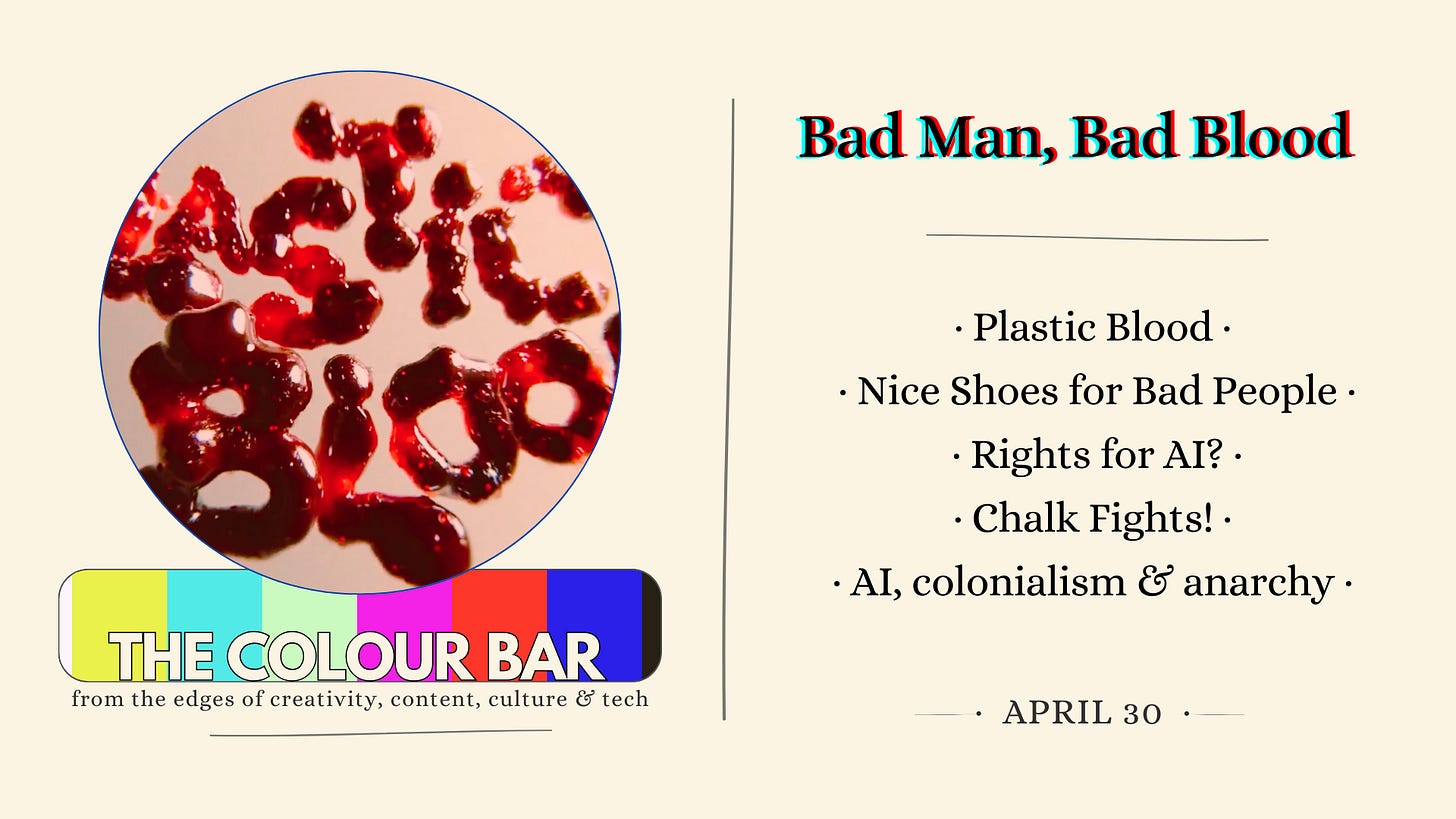Bad Man, Bad Blood
· Rights for AI · Plastic Blood · Nice Shoes for Bad People · AI, colonialism & anarchy ·
Should AI should have rights? Is plastic worth bleeding for? Are bad men worthy of good shoes? Are you having any fun?
Hello! Shakey here, and this is The Colour Bar. Thanks for letting me into your inbox. If you’re a new subscriber, welcome! This newsletter brings you weekly curations in media, content, creativity, tech, brands & humanity.
Today we traverse human blood, free speech for AI, teen athletes and two very different brushes with colonialism.
▶️ Curated/Cuts enjoys long-form advertising from Nike, a gaming spot without any gaming, and the celebration of an iconic magazine.
➕ There’s quickies on Fortnite & Coachella, Netflix’s new subs, media disruption through the lens of price deflation, and ideas for rescuing beloved franchises.
This is the Colour Bar- where creativity, content, culture, tech, brands & humanity collide.
So let’s bloody start then! No, I mean today has a bloody start.
Plastic Blood
The human body is widely contaminated by microplastics.
Microplastics are broken down from plastic waste. They have polluted the entire planet, from the peak of Mount Everest to the ocean depths. We consume the tiny particles via food, water and by breathing them in. Some estimates eye-catchingly claim we consume up to a credit card worth every week! They have been found in blood, semen, breast milk, placentas and bone marrow. The impact on human health is largely unknown, but they have been linked to strokes and heart attacks; and levels of microplastics in human brains may be rapidly rising.
Braziian biotech company OKA’s ‘Plastic Blood’ project transforms human microplastics into everyday objects. To bring the problem of microplastics into focus, Oka and DM9 found a tactile solution, making us, quite literally, feel it.
“Either we get rid of the plastic or the plastic will get rid of us.”
🎬 Curated/Cuts.
1. Bad Luka Nice Shoes
One Bad Man. 2 Nice Shoes. 12 Jurors.
In The Trial of Luka Doncic, Nike delivers a short film that embraces the superstar basketballer’s controversial persona, putting him on trial for his ‘bad behaviour’. The courtroom scene very quickly shows its hand- it’s meant to be a cheeky take on his image, while placing his shoes in hallowed light (quite literally). It tries, amusingly, to grapple with the question- How can such a bad man have such nice shoes?
Two quick takeaways.
One, its a fine example of how ‘longer’ storytelling can work for brands. Yes, even (especially) in these times of attention paucity.
Second, it is another instance of Nike grabbing the unfiltered, unapologetic, provocative image it showed us first last year in ‘Am I a Bad Person?’. The humour carries the conceit that bad behaviour doesn’t matter in the service of great athletes and gorgeous shoes.
· Director Jody Hill · Production Caviar ·
2. Everybody Loves a Fight
Chalk Fight!!! Please report to class and answer the question, are you having any fun? If not, why not?
Where are all the teachers? Are they playing Wordle? Do you care?
An ad for Battlegrounds Mobile India (hmmm, I have featured them a couple of times now) ; with not a single shot of screens or devices or gameplay. Me like.
The song is ‘Are you having any fun’ by Elaine Stritch, from way back in 1956. Clearly the question of having fun is always relevant.
Agency: Enormous · Good morning Films · Directed by Akanksha Seda ·
3. New Yorker 100
The New Yorker magazine celebrated 100 years in February. For many, maybe more so for those not immediately in the zeitgeist of New York/ the USA, the most iconic part of the magazine has been its illustrated covers. Even viewed from a cultural distance, they often manage to be both visually arresting and editorially weighty. This has been a century of aesthetic consistency- and resilience; every cover has been just the single, textless illustration, with no words besides the magazine name, issue date and price.
The magazine released a spot, ‘Everything, Covered’ that takes a brisk stroll through some of the most iconic covers. They chose about 700 from the more than 5000 covers there have been, bringing them together with animation while leaving all untouched.
More here if you are inclined, and a piece with editor David Remnick about the ‘dedication to literate, conversation-provoking and veracious reportage’.
· Roof Studio · Le Truc · music: Human ·
Bring on the Anarchy
I really enjoyed reading The Anarchy from William Dalrymple some years ago. While it was eye opening and arresting, it was also cinematic (and dramatic, the plots and machinations would give GoT a run for its money). The epic— also part of his wonderful ‘Company Quartet’ of books— chronicles the East India Company’s incredible operation from a small London office; Dalrymple described it as “a dangerously unregulated start-up”. A start-up that manufactured the takeover of the Indian subcontinent; at the time India constituted more than one-fourth of the world’s GDP.
I have, since, looked to keep track of how the book adaptation is going. Roy Kapur Films have been bringing forces together with Wiip. Now, Oscar-nominated director Stephen Frears has been brought on to direct and executive produce. An international co-production, it will “reunite screenwriters Walon Green, Amit Bhalla and Lucas Jansen, the creative team behind Apple TV+’s “Hello Tomorrow!” The series will be produced across the U.K. and Asia.”
Promising.
AI
Free Speech for the Bots!
So Character.AI is an AI-powered chatbot platform that lets users interact with and create virtual characters, each with unique personalities, behaviours, and backstories. Users can chat with characters based on real people, fictional figures, or entirely original creations, and even build their own characters for others to interact with.
Last year, the platform had a lawsuit filed against it , after a fourteen year old tragically died after interacting with its bots. Now, Character.AI has asked for the case to be dismissed, on the grounds that the outputs from its chatbot are protected speech under the First Amendment in the USA. That’s right, time to stand up for free speech for the robots!
The potential consequences of this are not trivial. If the platform is successful, AI-generated output like chatbot responses— could gain protection.
“It also raises a sticky legal question: If the responsibility for AI-generated outputs (and thus any resulting harm) lies with the AI bots themselves rather than the companies that developed them, who should be held liable for damages caused by these products? This issue could fundamentally reshape how the law approaches artificial intelligence, free speech, and corporate accountability.”
I recall, from my junior school ‘Civics’ textbooks, the phrase “rights and responsibilities “. The two tend to often go hand in hand. A right to free speech should then come with responsibilities that a citizen who enjoys must carry. No? Are AI-led platforms ok with that?
Related: Character driven chat bots are designed to be interactive, but also to get better via chatting with us. Every response is a data point feeding both the training and the company value. Hence, their interactions are usually engagement-focused, built to perpetuate conversation and keep us ‘users’ engaged as long as possible.
Sound familiar?
Empire of Extraction
Excellent piece on the parallel’s of today’s AI race and empire-building, with imperial conquests from days past. The parallels are all too real; yet I fear the biggest of them is that assumptions can and will be made (and are being made) about human effort, and the companies who carry out this get to define progress.
Swap out spices and cotton for content and code, ships for servers, and you don’t have to look hard to see the historical parallels.
Much like most of colonialism, the march will continue (relatively) unchallenged, tom-tom-ing progress; the land grab will be seen for what it was, only much later- if not retrospectively. It makes one wonder about history and its lessons we (choose to not) learn, and in that light, the piece from Nicholas Pickard is a worthy perspective to consider.
Sport: Prodigious Concerns
I wrote last week about the explosive debut from a fourteen year old in the IPL, India’s flashy and lucrative Cricket league. A little over a day ago, he stormed into our imagination again with a spectacular century, smashing records and taking his team to victory. One can’t overstate how special the feat is, and the buzz is palpable, even from very casual cricket followers.
I find every celebration of this prodigious talent accompanied by my ardent hope that he has the right people aroundm him. The structure, the cocoon, the wisdom that can allow him to grow the talent but also himself, not stubbing out- wittingly or not- a teenager’s evolution in favour of fame (or fortune). This short piece from December, when he was picked for the Rajasthan team, is worth revisiting. Do we need some regulation and structure around how we treat minors playing professional sport?
”It is perhaps time for governing bodies to bring in regulations for the engagement of minors in professional sport to ensure they are not only protected from commercial exploitation by those who control them but also to ensure sport does not come in the way of their educational, emotional and social development,” said sports lawyer and author Nandan Kamath.
➕Quickies
Netflix is rolling out a new way to experience subtitles, if you’re one of those who keep the subtitles on even for shows in a language you understand. That’s right, no more reading ‘emotional music swells’, or ‘door clicks open’ or ‘cutlery clinks’.
“There’s no doubt about it – a worrying number of what used to be the world’s most untouchable franchises are in trouble. But how did they arrive at this point of terminal audience ennui?” Luke Holland claims to have figured out how to save all those beleaguered franchises (because, of course, franchises are and can be our only real saviours).
The consistently thought-provoking and insightful Doug Shapiro’s latest piece looks at a ‘stubbornly persistent consequence of disruption’ - price deflation. He endeavours to look at the long term implication, especially as Gen-AI promises to bring down the cost of content even more dramatically, causing further disruption. What will be scarce in a world of limitless content?
Fortnite launched a game with Coachella last week, with custom music-themed weapons & consumables; licensed tracks from Coachella artists and more.
“Along with historical grandeur and the near mythic setting of this story, there’s something else that rings disturbingly familiar: an epic venality; wherein a handful of wealthy men to enhance their personal fortunes and gratify the extremes of their egos can manipulate the destiny of millions.”
_Walon Green on The Anarchy




